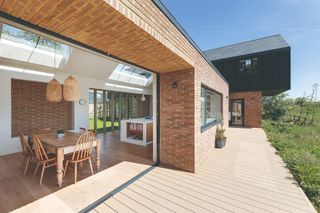I'm a Passivhaus designer and this is how to reduce your carbon footprint when building
Architect and Passivhaus designer Tara Gbolade shares her tips for how to reduce your carbon footprint when building or renovating the home of your dreams

As an architect and a Passivhaus designer, I am often asked about how to reduce your carbon footprint when building. It’s a great question, and one that I’m passionate about answering.
In this article, I'll provide an overview of what 'carbon impact' means in the context of building or renovating a home, and why it’s important to consider your carbon footprint at every stage of the building process. I'll also be sharing my top tips for self-builders looking to reduce their own environmental impact.
I'll be drawing from my experience of retrofitting my ownPassivhaushome and sharing some of the challenges and lessons I learned along the way.
Reduce your carbon footprint when building
Firstly, when discussing the carbon impact of a building, we often consider two major types: operational carbon andembodied carbon.
Operational carbonrefers to the carbon emissions generated during the life of the building due to activities like heating, cooling and lighting. Traditionally, the focus of green building practices, such as building a passive house, has been on reducing this operational carbon footprint, primarily through improving energy efficiency and using renewable energy sources.
Embodied carbon, on the other hand, refers to the carbon emissions associated with the entire lifecycle of a building, from the extraction and manufacturing of materials, to transportation, construction, maintenance and, finally, end-of-life disposal or recycling. This includes both upfront embodied carbon (carbon emitted during initial construction) and long-term embodied carbon (carbon emitted during maintenance, renovation, and eventual demolition or deconstruction).
Reducing operational carbon
As an industry, self-builders and renovators have become better at understanding and reducing operational carbon. Through building orientation, adopting a fabric-first approach (insulating walls, floors, roof), and the implementation of efficient Passivhaus ventilation systems, like mechanical ventilation with heat recovery (MVHR), we can enhance occupant comfort.Passivhaus homes,in particular, are a benchmark in achieving these efficiencies, though some might be concerned about the initial Passive house cost. Over the long term, however, the benefits often outweigh the upfront investment.
However, we still find it challenging to reduce our embodied carbon. Hence, focusing on embodied carbon becomes pivotal as operational energy efficiency improves and more renewable energy is used.

Reducing embodied carbon
In some cases, embodied carbon can represent over half of a building’s total lifecycle carbon emissions. Many building materials, such as concrete and steel, are resource-intensive to produce, significantly contributing to embodied carbon. Therefore, promoting sustainable sourcing, production practices, and the use of alternative, lower-carbon materials becomes essential.
The concept ofcradle-to-cradlelooks at the lifecycle of materials to ensure that they are both sustainably produced and can also be disposed of in a sustainable manner. These materials could be recycled, re-used or made from biodegradable materials.
Using locally sourced materials is an excellent way to reduce the embodied carbon of your project. Transporting materials over long distances generates a significant amount of carbon emissions. By sourcing materials locally, you can significantly reduce this.
Reducing embodied carbon often goes hand in hand with principles of the circular economy too, such as designing for disassembly and maximising the reuse and recycling of materials. Reusing materials means you are using materials that have already emitted carbon during their manufacturing stages, so there is no need to create more emissions. Repurposing materials such as brick, reclaimed wood, or stone can provide a unique and sustainable aesthetic for your home.
The use of low embodied carbon materials such as timber, which can be used for your structure, and wood fibre and straw bales, which can be used for your insulation, are sustainable options that can significantly reduce your carbon footprint. High carbon footprint materials, such as concrete and steel, should be eliminated where possible, or used sparingly, and where necessary, you should consider using recycled versions of these materials.

Reducing our carbon impact moving forward
Our practice,Gbolade Design Studio, is constantly using innovative ways to address both operational and embodied carbon, and have seen a significant increase in working with clients and consultants to address this critical issue. It is also important to recognise that our industry regulations are changing to recognise the importance of embodied carbon, and this is expected to continue in the future.
I would recommend aiming for a performance standard such asEnerPhitor LETI (Low Energy Transformation Initiative) retrofit from the outset. These standards provide a clear roadmap for achieving a sustainable home and can help guide your decision-making throughout the project.
In conclusion, reducing both operational carbon and embodied carbon must be considered critical. By starting with a whole-house retrofit plan, working with experts in the field, designing and building a beautiful low-energy home that benefits both you and the planet, you can make a worthwhile difference.
Get the Homebuilding & Renovating Newsletter
带着你的梦想家园生活专家建议,how-to guides and design inspiration, direct to your inbox.
塔拉是一种被动式住宅设计师和基于“增大化现实”技术的创始人之一chitectural practice Gbolade Design Studio and won the RIBA Rising Star Award in 2018.
- Gabriella DysonAssistant Editor
带着你的梦想家园生活专家建议,how-to guides and design inspiration, direct to your inbox.
Thank you for signing up to Homebuilding. You will receive a verification email shortly.
There was a problem. Please refresh the page and try again.

